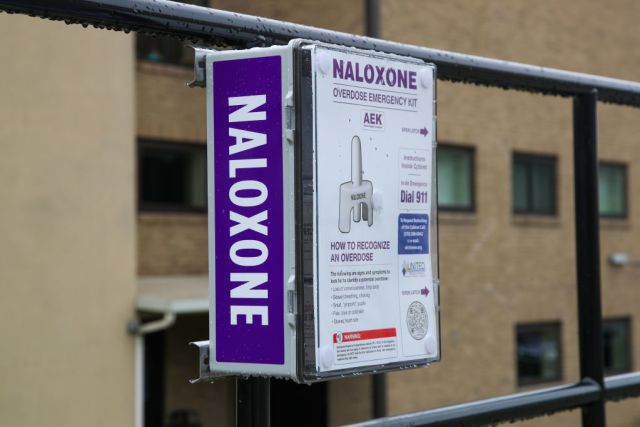Updated on February 16, 2024.
In 2001, fewer than 20,000 people in the United States died of a drug overdose, according to the Centers for Disease Control and Prevention (CDC). By 2021—just 20 years later—that number increased to nearly 107,000 people. About 75 percent of those deaths involved opioids such as heroin and fentanyl.
Though overdose deaths have been climbing rapidly, many thousands of people survive overdoses each year thanks to naloxone hydrochloride, also known as naloxone or by the brand name Narcan. Administered via nasal spray, injection, or intravenously (via IV), naloxone can reverse an opioid overdose and restore breathing within 2 or 3 minutes.
“I’ve had occasion to give it to people from time to time, and people wake up in seconds,” says Keith Roach, MD, associate professor in clinical medicine in the division of general medicine at Weill Cornell Medical College and New York Presbyterian Hospital. “It’s one of the most dramatic things you can see in clinical medicine.”
Today the medication isn’t just reserved for use by paramedics, EMT workers, and healthcare providers (HCPs). People at risk of overdose, those who deal with people at risk of overdose, and many others can have the medication on hand.
Anatomy of an overdose
When someone takes an opioid, its molecules bind to a part of the cell called a receptor. This makes users feel euphoric and dulls their perception to pain. Those receptors also blunt the body’s ability to regulate breathing. If the opioid dose is high enough, breathing stops entirely.
“It’s a powerful effect on the brain itself. The area of the brain that tells you to breathe stops working,” says Dr. Roach. “You die from opiates because you essentially forget to breathe.”
In addition to slow, shallow, or no breathing, signs of an opioid overdose include:
- Unconsciousness
- Pinpoint pupils
- Gastrointestinal problems
- Anxiety and paranoia
- Depression
- Hallucinations
- Slow heartbeat or low blood pressure
How naloxone works
Naloxone molecules bind to the same receptors as opioids and prevent the opioids from working. They also push the opioid molecules out of the way, knocking them off the receptors and reversing the effects. This allows the person to breathe again—but it may also induce withdrawal symptoms.
“Nobody likes to get naloxone because it’s such an unpleasant wakeup call,” says Roach. “People are not happy about it, because for whatever reason they took the opioid in the first place, all of the benefit would go away.”
How to use naloxone
Naloxone is available as a nasal spray, an auto-injector, or a pre-filled syringe. In a hospital, if the drug is delivered directly into a vein via IV, it works almost instantly. The auto-injectors and pre-filled syringes are designed to be jabbed into a muscle, which works slightly slower than an IV, says Roach. The nasal spray is the slowest, but “the advantage of giving it nasally is that anyone can do it,” he adds.
It’s essential to be trained in the use of naloxone if you’re expecting to provide a dose, or if you’re depended on to dispense the medication, says Roach. That means asking an HCP to show you how to use it properly.
“Many communities in most states have the ability for citizens to give it and have Good Samaritan laws to protect them,” Roach explains. “But you want to be sure you know exactly how to do it.” As of 2021, 47 states and the District of Columbia had Good Samaritan laws in place to legally safeguard people from criminal penalties if they dispense naloxone to reverse an overdose.
Naloxone is only a temporary treatment, so it’s very important to get medical help as soon as possible after it’s given to someone. Always call 911 in addition to administering naloxone in the event of an overdose.
How to get naloxone
Naloxone is available in all 50 states. It’s legal for anyone to carry and administer it, and it’s available with or without a prescription. First responders, like paramedics, typically carry naloxone, but it’s also offered at many healthcare settings, community distribution programs, and public health groups.
In March 2023, the U.S. Food and Drug Administration (FDA) approved the first over-the-counter (OTC) naloxone nasal spray for anyone who wishes to use it. Some insurance plans may cover the cost of OTC naloxone, but many others will not.
In most states, people can also buy naloxone without a prescription thanks to a “standing order.” This means an HCP can prescribe the nasal spray to a pharmacy (versus an individual), allowing sale of the medication to anyone who walks in and requests it. One key advantage to obtaining naloxone this way (versus OTC) is cost; insurance plans typically cover naloxone distributed via standing order.
With the introduction of the new OTC form of naloxone, retailers like pharmacists no longer need to be trained in its administration or teach consumers how to use it. It's also increasingly available for free in vending machines and other public distribution sites in many cities and communities. Training is still recommended to make sure you’re as ready as possible in an emergency.
“Studies show that in communities with more access, there are fewer deaths from opioids. Anything we can do to reduce the number of deaths is a good thing,” says Roach
Bottom line, naloxone is now cheaper and easier to access than ever before, and can help in an emergency. If you or someone you know is at risk of an opioid overdose—especially if there’s a history of opioid use disorder—keeping naloxone on hand could save a life.







